NEBRASKA PUBLIC POWER DISTRICT
CUSTOMER MEETING ON ENERGY ALTERNATIVES
EXECUTIVE SUMMARY
Following are broad conclusions and observations the Public Decision Partnership draws from the attached survey results and from observations at the event. The survey data are extensive and the authors direct those with detailed questions to the data itself.
Conclusions from Survey Results
• The NPPD residential customers who
participated in the customer meeting constitute a valid sample of NPPD
wholesale and retail residential customers (page 7).
• The 109 customers who attended the customer meeting, reasonably match the comparative demographic base lines for NPPD established by the larger telephone sample of 1,351 customers and the internal profile assembled from year 2000 census data. The answers on issue questions of the larger telephone sample reasonably match the pre-meeting answers of meeting participants (pages 29-31).
• Confidence limits are ±10% at 95%; in other words, 95% of the time, if all customers were asked the same questions, their responses would not vary by more than ±10%.
• The results can be extrapolated to NPPD residential customers as a whole, within confidence levels stated above.
• NPPD
residential customers overwhelmingly support the development of
the wind projects described in the materials and at the meeting (page 10).
• 96% think the 200 MW wind addition should go forward.
• Renewable energy incentives do not make a difference in customer support for the 200 MW wind addition.
• 50% think 200 MW (or 5% of energy) is about the right size, 37% think it should be expanded, 3% think it should be reduced.
• NPPD
residential customers voice strong support
for the methane (animal manure) projects described at the event
(page 12).
• 81% think the 5 MW of methane development should go forward
• 44% think 5 MW is about the right size, 29% think it should be expanded; 5% think it should be reduced.
• NPPD
residential customers overwhelmingly think the cost of
renewables should be a system resource paid for by all customers
(page 14).
• 94% say divide the cost among all customers; 2% say bill the customers who want renewables
• Support for additional renewables paid for by green marketing programs is moderate (53% yes, 19% no).
• Use
of
• 65% said very important
• 28% said somewhat important
• 2% said not very important
• Customers
cite a variety of reasons for favoring more renewable
energy. No one reason dominated (page
26).
• Customers
are not driven to renewables by concern over environmental
problems in their area (page 28).
• 3% said environmental problems were serious, 11% said moderately serious, and 18% said somewhat serious.
• Responses to a question on air pollution were similar.
• A slight majority (58%) expressed concern over climate changes associated with global warming.
• Customers
liked the customer meeting and found it valuable, fair,
and balanced (pages 29-30).
• 61% said extremely valuable, 32% said valuable.
• 65% said the meeting was very fair, 18% said it was fair.
• 79% said the materials were mostly balanced; 16% said the materials favored some positions over others.
Observations
• The participants were predominately rural (78%) and therefore typically older than a cross-section of the population in a more urban area.
• Participants like the service provided by NPPD and the other retail utility suppliers. There was little evidence of customer dissatisfaction or underlying issues.
• Both coal and nuclear options fared better
than they have in other areas of the
• Conservation was not fully explored as a resource option due to time but appeared to have considerable support. The same could be said, but to a lesser extent, for solar options, especially in pre-event results
• NPPD staff seemed to enjoy and benefit from a chance to interact with a scientific sample of customers (one of everything). Staff likely learned as much from the day as did customers, just in different areas.
• Customers appreciated being asked their opinion and took the questions seriously. Many traveled from a great distance. They would like to be kept informed.
• The sample could be used for other research.
NEBRASKA PUBLIC POWER DISTRICT
CUSTOMER MEETING
ON ENERGY ALTERNATIVES
Summary of the Process
On
Topics of Discussion
The major topic of discussion centered on customer values and preferences concerning whether NPPD should continue, decrease, or expand the system commitment to renewable resources. The specific projects discussed as examples were to add 200 MW of wind power by 2010 (5% of annual electrical energy) and 5 MW of methane generation (over 5 years) produced from animal manure. The two renewable examples were compared against fossil generation represented by a 250 MW combined cycle gas plant under construction, and a 150 MW participation in a large coal plant using “best available control technology” planned for operation in 2009.
The Process
The process used at the Customer Meeting was Deliberative Polling™ as developed by Professor James Fishkin at The University of Texas at Austin (Professor Fishkin is now located at Stanford University) and licensed through the Stanford Center for Deliberative Democracy. The process samples informed opinion on an issue—in this case, options to meet the need for future generation. The process reveals what participants feel about an issue after having had a chance to read, think, discuss, and ask questions of experts and advocates.
Potential participants were selected through random digit
dialing and administered a questionnaire on electricity issues. Once they completed the questionnaire, they
were invited to participate in the Customer Meeting. Participants arrived at the event and were
assigned randomly to 8 small groups of 13-15 people. A trained, neutral moderator (not an NPPD
employee) led each small group through a discussion of the issues. The issues were outlined in a set of
materials delivered to participants approximately two weeks in advance of the
event. Participants alternated between
small group sessions and large group sessions, where participants asked
questions of panels composed of subject-matter experts and advocates for
different resource solutions. An outside
moderator led the large group sessions.
(Ron Lehr is an attorney in
The Customer Meeting was videotaped by NETV of Lincoln as part of preparing a documentary on the event. The entire process was open to the press and observers.
The findings in this report can be compared with eight similar customer meetings on energy alternatives conducted in Texas by investor-owned utilities in the 1996-1998 timeframe.* The NPPD Customer Meeting is significant because it is the first new Deliberative Polling data on energy alternatives in five years, is the first application by a public power entity (customer-owned versus investor-owned), is the first Deliberative Poll in the Midwest, and is the most rural of the samples selected (reflecting the NPPD service territory, 78% of the telephone sample participants reported they live in an area with less than 50,000 people).
Design and process consultation for the Customer Meeting was provided by Dennis Thomas, Will Guild, and Ron Lehr through the Public Decision Partnership.
Advisory Group
NPPD convened an Advisory Group of diverse viewpoints on the issues to be discussed. Representation on the Advisory Group came from the NPPD service area as well as from interested groups. The responsibility of the Advisory Group was to see that the survey, materials, and the large group panels represented a fair balance of viewpoints. The Advisory Group met three times and contributed many hours toward ensuring the process was fair and balanced.
Participant Reaction
After 8 hours of discussions, the customers gave NPPD high marks for the process. On a 7-point scale with 7 as “extremely valuable” 93% rated the day a 6 or 7.
Confidence Levels and Experimental Design Factors
Since it is not possible to have all NPPD wholesale and retail residential customers together at the same event, a “Customer Meeting” of randomly selected individuals was used as a surrogate. Confidence levels for the results from the Customer Meeting are ±10% at the 95% confidence level. In other words, one can say that, if all NPPD residential customers had been given the same survey, we can be 95% confident their collected opinions would not differ by more than ±10% from the results produced by the Customer Meeting. The confidence level for the larger pre-event survey (1351 participants) is slightly higher and is ±3.5% at the 95% level.
The demographics of those who participated in the larger pre-event survey were checked against the demographics of those who participated in the event. In general, the demographics of the two groups and their attitudes on the indicator questions are very similar. The exception is the small sample was slightly more educated (8% more had college degrees). It would be possible to weight the results, for education or any other variable felt to be under-represented, but the authors do not believe weighting to be necessary in this case. As is the usual practice in research of this nature, participants were paid an honorarium of $150 and those traveling over 100 miles (approximately 60%) were offered a hotel room and hotel meal vouchers.
Format of the Report and Data Availability
This report provides a summary of the data resulting from the Customer Meeting. The entire data file is available on request.
All charts show results from the post-event questionnaire unless otherwise specified. When charts show pre-event and post-event numbers, the answers are from the pre-event and post-event questionnaires for those who attended the event (N=109). The section on representativeness of the event sample compares those who attended with the whole pre-event sample (N=1351).
Funding Assistance
Funding assistance was provided by the Western Area Power Administration (WAPA) and the Nebraska Energy Office.
* Listening to Customers: How Deliberative Polling Helped Build 1,000
MW of New Renewable Energy Projects in
Contact Persons For more information about the NPPD Customer Meeting on Energy Alternatives, contact:
Jon Trabert Nebraska Public Power District (402) 563-5044
Frank Thompson Nebraska Public Power District (402) 563-5696
Authors of this report (and sources for more information on methodology) are:
Will Guild, Ph.D.
The Guild Group and Public Decision Partnership
512/328-6496 wguild@gldgrp.com
Ron Lehr
Ron Lehr, Attorney and Public Decision Partnership
303/504-0940 rllehr@email.msn.com
Dennis L. Thomas, Ph.D.
Dennis Thomas and Associates and Public Decision Partnership
512/478-8557 dta@jump.net
Results
Response to Proposed Projects
The most critical findings may be those tied to the two projects being considered by NPPD. For both of these projects the survey only questioned participants at the end of the customer meeting because at that point they were familiar with the tradeoffs involved in these energy sources.
One of the projects being considered is 200 MW of wind energy that would provide 5% of NPPD’s energy needs. Respondents were given the following description of the project:
Over the next 10 years NPPD expects the demand for
electricity to continue to increase. One
course of action NPPD is considering, calls for an additional 200 megawatts of
wind power by the year 2010. This would
mean that by the year 2010, about 5% of NPPD’s total electric energy produced
would come from wind power.
The cost of this power would mean that residential bills
would increase by approximately 1% to 2% over what they would be
otherwise. For the residential customer
whose bill averages $100 a month, this would mean an increase of $1 to $2
dollars a month. Increases in Commercial
and Industrial customers’ bills would be approximately 1.5% to 2.5%, which for
an average monthly bill of $1,000 would mean an increase of $15 to $25.
They were then asked whether they believe NPPD should go forward with the program. After responding to the initial description of the program participants were told of a possible federal renewable energy incentive that would mean that NPPD could build a wind farm with no increase in rates. The specific wording is as follows:
It is possible that there will be a
federal incentive for renewable energy.
If this were available, there would be no increase in rates or bills
over what they would be without a wind farm.
Participants were asked if NPPD should go forward with the project if this renewable energy incentive was available.

The results indicate overwhelming support for the project, even without a renewable energy incentive.
The survey explained that if the size of the wind farm was increased, the cost to consumers would increase proportionately and if it was reduced, the cost would decrease proportionately. Following this explanation the survey asked whether participants thought the wind farm was the right size or if it should be expanded or reduced.

Only three percent wanted NPPD to build a smaller wind farm while about a third (37%) wanted a larger one.
The survey asked how large a wind farm the participants would like to see NPPD build, with and without the renewable incentive. The chart below shows the response to this question. Those who responded “don’t know” or who did not want NPPD to build a wind farm do not appear in the chart which is why the percentage on the left side of the chart does not equal 100%. This is a cumulative chart. To interpret the chart, start at the left hand side. With the renewable energy incentive, 85% of participants wanted at least 1 to 99 megawatts of wind power. Eighty-two percent (82%) wanted at least 100-199 megawatts, 77% wanted at least 200 megawatts, 52% wanted 201 to 299 megawatts and so on.

This chart again demonstrates very strong support for a 200 megawatt wind farm and substantial support for even more wind power, particularly if there is a renewable energy incentive.
The second project addressed in the survey was five megawatts of electricity from methane. Participants were given the following description of this project.
Another course of action NPPD is
considering is development of 5 megawatts of power produced from methane gas
that comes from animal manure, to be added over 5 years. The cost of this power would increase bill
less than 0.1% over what it would be otherwise. For the residential customer whose bill
averages $100 a month, this would mean an increase of 10 cents per month.
Again, participants were asked whether they believe NPPD should go forward with the program. As in the case of the wind project, after responding to the initial description of the program, participants were told of a possible federal renewable energy incentive that would mean no increase in rates for the methane project. Participants were then asked if NPPD should go forward with the project if this renewable energy incentive was available.

The strong level of support for the methane project was not affected by the possible renewable energy incentive.

Slightly less than half the participants (44%) thought the methane project was about the right size, 5% wanted NPPD to build a smaller project and about a fourth (29%) wanted a larger one.
The survey asked how many megawatts of methane participants would like to see NPPD build, with and without the renewable incentive. The chart below shows the response to this question. Again those who responded “don’t know” or who did not want NPPD to build a wind farm do not appear in the chart, which is why the percentage on the left side of the chart does not equal 100%. Respondents were told on the survey that 50 megawatts was the maximum feasible amount of methane projects that could be built.

As was the case with the wind project, the chart demonstrates very strong support for a 5 megawatt methane project and substantial support for even more methane, particularly if there is a renewable energy incentive.
How should NPPD invest in renewable energy?
A critical question for utilities considering renewable projects that are more expensive than fossil alternatives is how to pay for these projects. Participants were asked about how NPPD should invest in renewable energy with the following question.
One way would be to build a project
such as the wind farm described above and to divide the cost, as well as any
benefits from the project (such as stable fuel costs), among all
customers.
Another way would be to market
renewable energy before building any
facilities to produce it. Customers
would be asked to commit to buy renewable electricity and NPPD would
only build facilities to produce enough renewable energy to meet the demand of
those customers who had committed to buy renewable energy. The cost and any benefits would only go to
those customers who had committed to purchase the renewable energy from these
facilities. How do you feel NPPD should invest
in renewable energy?
(a.) By
building facilities that would provide renewable energy for all customers
and divide the cost among all customers ......................................................................................................................
(b.) By building
facilities only for those customers who commit to pay for renewable
energy and having only those customers pay for the renewable energy..............................................................
(c.) I don’t want NPPD to invest in renewable
resources ....................................................
(d.) Don’t know
Participants were almost unanimous in their support of building facilities and dividing the cost among all customers.

One option utilities sometimes consider is building a base amount of renewable energy resources and dividing the cost among all customers and then adding more as a “green resource” option. In that vein participants were asked if they thought it would be a good idea to have all customers pay for a base amount of renewable resources, but allow those who wanted more to purchase additional renewable energy and build additional facilities to meet this demand.

Responses to this option were moderately positive, with just over half (53%) in favor of it and only 19% opposed.
Attitudes Towards Options
In addition to asking participants about specific projects, the survey also queried them about a number of more general options to meet future energy needs. Unlike questions about specific projects, these were asked when participants were initially surveyed as well as at the conclusion of the event. This allows NPPD to see how attitudes changed as people came to know more about the options and to discuss tradeoffs with fellow customers and experts.
One of these questions simply asked how important it is for NPPD to focus on different options to meet future energy needs.

Conservation and wind power were both seen as highly important both before and at the conclusion of the NPPD customer meeting. The perceived importance of solar power as a option for NPPD to focus upon was strong before the event, but dropped 30 points at the conclusion. While coal was not seen as one of the most important options, its perceived importance increased at the conclusion of the customer meeting.
In addition to looking at the perceived importance of options the survey also asked which options participants felt NPPD should pursue first.
 -
-

Wind power was selected most often as the option NPPD should pursue first both before and at the conclusion of the customer meeting. The percentage of participants selecting solar power dropped very substantially, while the percentage choosing conservation increased substantially at the conclusion of the meeting. The percentage choosing coal as the first option also increased significantly compared to the initial results.
The chart below shows the pre and post results for which option participants would want NPPD to pursue first, second and third among seven options which were given to respondents.

Another way the survey examined the value participants associated with different ways of meeting energy needs was by asking them the following.
Some of the options, which were just mentioned, could be more expensive while others could be less expensive. As a way of determining how much value you place on each option, please tell us how much more, if anything, you would be willing to pay above your current monthly electric bill to have your utility pursue each option.
The authors caution against looking at this data as a way of determining what customers would actually pay for each resource, as there are many other variables that could affect actual customer behavior. However, this is a useful way to look at how they value each resource relative to the others.
Responses to these questions were open-ended. They were coded and grouped into categories. The charts below have the following groupings, $1.00, $1.01 to $2.00, $2.01 to $3.00, $3.01 to $4.00, $4.01 to $5.00, $5.01 to $10.00 and more than $10.00. Those who responded don’t know do not appear on the chart. Reading from left to right, at each point the percentage shown is the percent willing to pay at least that much. The order of the graphs is from greatest post event value to least post event value.

Wind was the most highly valued option and the perceived value of this resource increased compared to the initial survey.

Participant’s perception of the value of pursuing conservation dramatically increased following the customer meeting. This option was second only to wind in the perceived value.

Methane was not as highly valued as wind or conservation, but over half the participants said they were willing to pay a something extra for NPPD to pursue methane. Note that in the post event results, the extra amount participants were willing to pay dropped quickly past the $1.00 mark.

The value of NPPD pursuing solar energy decreased following the event.
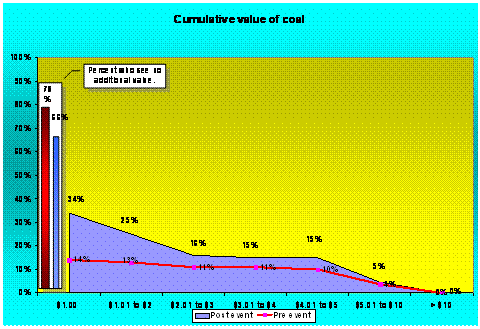
The post event value of coal and natural gas are very similar. The value participants gave to coal went up following the customer meeting.

The perceived value of natural gas also went up slightly following the meeting.

There was a very slight decrease in participant’s valuing of nuclear power following the meeting.
Values of Participants
Customer values related to electricity were also examined as part of this project. In one set of questions the survey examined the importance of five factors. These factors were:
To receive electricity at the lowest cost.
To protect the people and the environment from pollution created by producing
electricity.
To be sure
there is enough electricity to meet needs now and in the future.
To have as few electric outages as possible.
To
produce electricity in ways that will benefit the state’s economy.
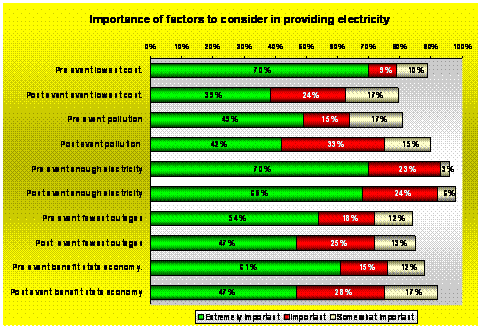
All factors are seen as rather important with lowest cost and enough energy for now and in the future receiving the highest percentage of extremely important ratings in the initial survey. This changed considerably in the post event survey.
The percentage of customers who responded that cost was
extremely important dropped from 70% to 39%, while the percentage that said it
was important rose from 9% to 24%. This
result indicates that cost did not become unimportant, but that when given
information and the opportunity to consider tradeoffs, cost is not quite as
important when put in the context of other factors. Interestingly, the percentage of respondents
indicating the various factors are “extremely important” dropped for every
factor except having enough electricity, while the percent responding
“important” tended to go up. This makes
sense given our past experience with Deliberative Polling. After the event respondents apparently give
more thought to their answers with the result that they make finer gradations
in importance ratings.
The survey also asked respondents which of the five factors were most important. As can be seen from the graph below, after the customer meeting, having enough electricity stood out as having the greatest importance.

Lowest cost and protecting people and the environment from pollution were the next most important factors, followed by benefiting the state economy and having the fewest outages. In past research experience the authors have found that people expect to have reliable electricity and because of this assumption, they tend to see reliability as less important than other factors. This picture changes rapidly when reliability issues appear.
The survey asked one question focused particularly on participant
view of the importance of using
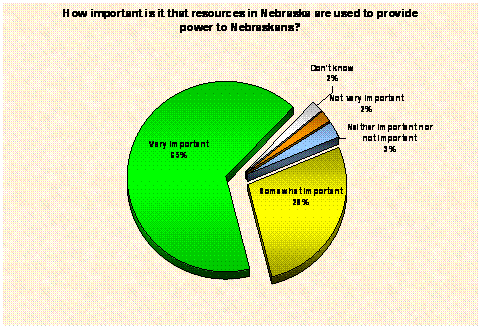
Two thirds of participants considered this to be important.
Most of the participants favored the development of renewable resources. As NPPD thinks about its long-term plans it maybe helpful to understand what objectives its customers wish to meet through the development of such resources. The survey asked the following question to explore these objectives.
People
might have different objectives they want fulfilled by having NPPD invest in
renewable technology. One objective is
to develop resources that will never be used up. Another is to create electricity in ways that
produce little or no pollution. A third
is to provide customers with more stable costs for electricity by getting rid
of variability in fuel costs. A fourth
is to provide a source of income for farmers who can lease their land for wind
turbines. A fifth is to help lower the
future cost of renewable energy by increasing the production of renewable
technology. Please indicate how you view
the importance of these by taking 100 points and dividing them among the
objectives in terms of how important they are to you. For example, if you think there is only one
important objective you might assign it all 100 points. If you think all three objectives are equally
important you might divide the points evenly.
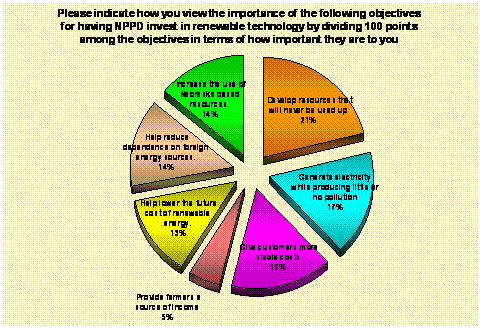
There is no one objective that is seen as most
important. Having sustainable resources,
controlling pollution, stable costs, reducing dependence on foreign sources,
using
Environmental issues
A number of environmental questions were included in the survey. One set of items concerned the importance of different environment issues in choosing a resource for electricity. This set of questions was only asked after the event.
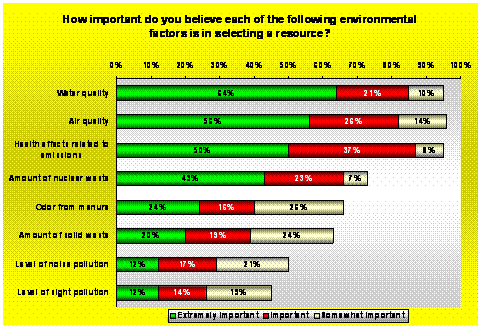
Water quality was the most important environmental factor for participants followed by air quality and health effects related to emissions. Participants saw environmental factors that would only affect the area immediately around the site of a power facility (noise or sight pollution) as much less important.
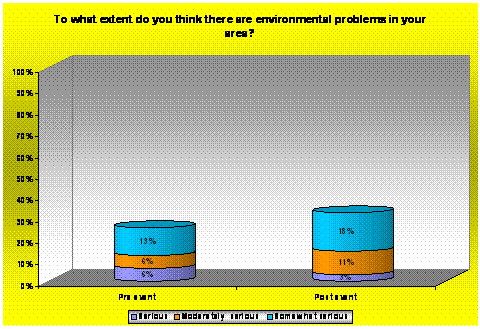
There is little concern about local environmental problems.
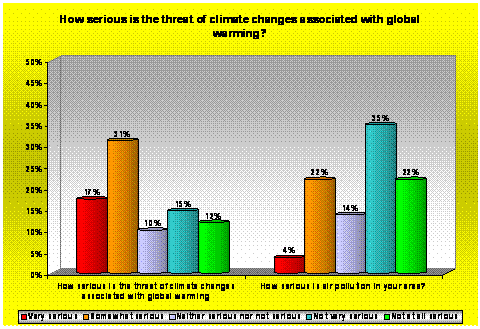
NPPD customers are more concerned with the threat of climate change associated with global warming than with local air pollution.
Ratings of NPPD Customer Meeting
In the last section of the post event survey, participants were asked to evaluate the customer meeting. One item in this section asked them how valuable they found the meeting.
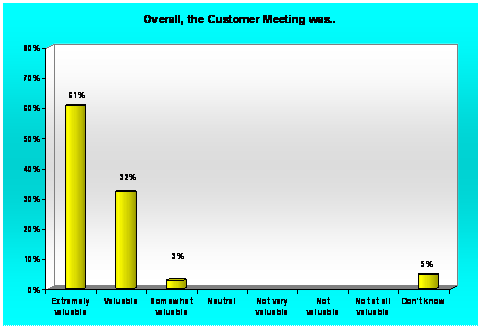
Almost two thirds (61%) gave the event the highest possible rating, extremely valuable. An additional 32% rated it as valuable. Not one participant rated the event negatively.
Participants were also asked whether they saw the meeting as fair or biased. The overwhelming majority saw it as fair.
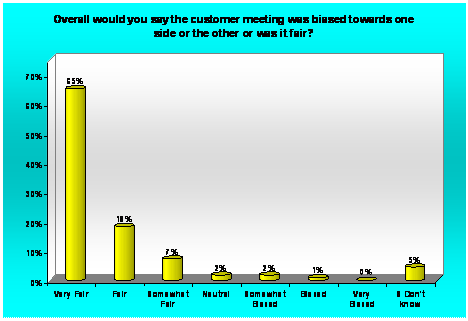
Finally, participants were asked whether the discussion materials were balanced or whether they favored some positions over others. Again, the vast majority saw the materials as balanced.
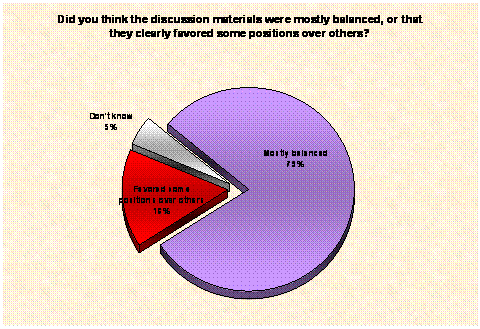
Comparing Customer Meeting Attendees to the Initial Telephone Sample
The following compares the large telephone sample (1,351) to the pre event response of the 109 participants of the NPPD Customer Meeting. Responses are compared on demographic variables and key attitudinal variables. While the group that attended the event was slightly more educated than the overall sample the authors conclude that no weighting of the results is necessary.
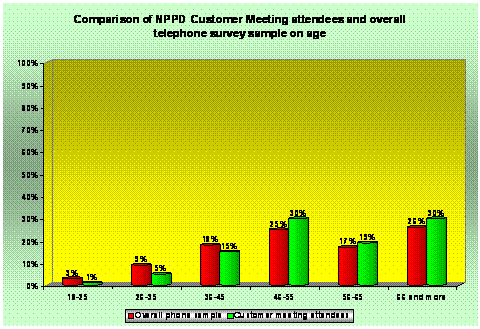
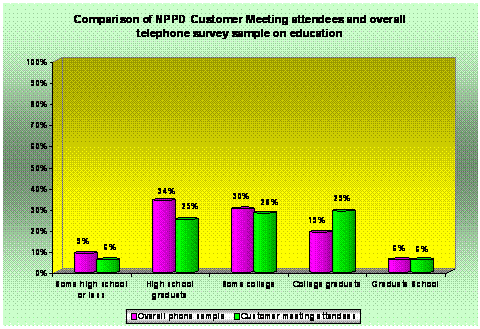
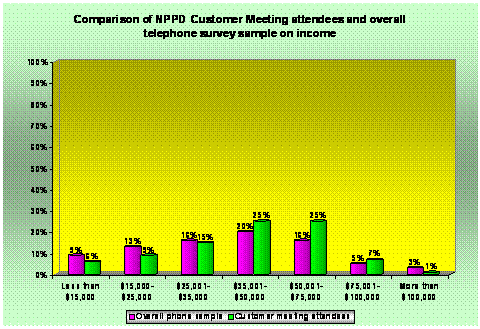
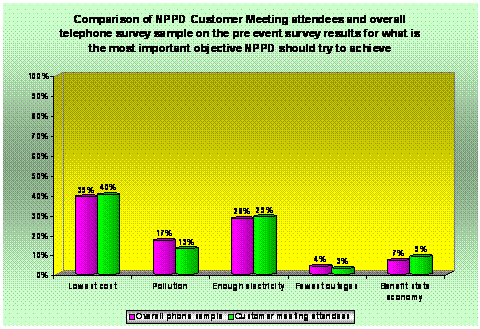

Appendix A
Participant Comments
|
Participant
Comments |
|
(Regarding question 23) I think
they should establish a policy on renewable energy and that should be passed
on to everyone - people just won't take the time or spend the money to get
involved in these issues. |
|
As a consumer, I believe NPPD
is doing a great job for what we pay.
And I do appreciate the fact we had the opportunity to learn more
about future goals of NPPD. Meeting
was great. Thanks. |
|
Conservation and education can
lower the cost by lowering demand.
Customers need to know peak load hours so they can be avoided. We (customers) can do a part as important
as building new and more plants!
Customers need to be informed and educated. |
|
Enjoyable meeting. |
|
Enjoyed my day. Information was great. Thanks. |
|
Enjoyed the day and very
informative. Thank you. |
|
Enjoyed the opportunity to
participate and appreciate the money spent by NPPD to facilitate this
meeting. Thanks so much and I hope to
hear updates on future decisions! |
|
Excellent meeting! I felt like I learned quite a bit. Thank you for the opportunity to
participate. |
|
Good meeting! |
|
Good meeting. NPPD should pursue other sources but only
if cost effective. |
|
Great meeting! Very efficient. |
|
Great meeting. It was enlightening to hear what other
customers thought and had experienced. |
|
Had a nice time, thank you. |
|
Having sat through numerous
boring teachers workshops and in service speakers, I
was a bit concerned about the use of my time today. I was rewarded with good information, which
was presented well. Thanks! |
|
I appreciate NPPD
everyday. What a luxury to get up, turn
up thermostat to get heat (thermostat is electric). So nice to turn on a light when I come
home. When we get rural public power
on my folks' farm - it caused house to become modern. |
|
I appreciate the information
for customers. |
|
I believe in our energy sources
being diversified. One never knows
what future will bring - or another Sept. 11th. We need to keep open minds at all times. |
|
I feel that R&D must be
funded to develop storage for wind power and some type of funding developed
for methane development. |
|
I have learned much more than I
knew about electricity. The info will
be useful. Thank you. |
|
I learned a lot. It opened my eyes to a lot of concerns that
I will share with my family and friends.
Why was the question about coal dust in the air not answered? |
|
I learned many new things. This was an educational experience. I feel the facilitators kept things moving
while giving everybody a chance to contribute. The information and considerations were
appreciated. |
|
I think for most part panel was
great! |
|
I think we are very lucky to
have NPPD. |
|
I think you need to expand the
wind resources and look for alternative resources to replace the natural gas
as it will run out. Look more into
methane gas from cattle - lots of feedlots are having problems with odor and
dust. |
|
I thought it was very
educational. |
|
I would like to have discussed
water. I've heard the Merritt Dam on
the |
|
If the moderator would have
read the submitted questions (I have a hearing problem) I believe response
would have been better. Great meeting! |
|
Initially I mentioned and still
believe nuclear power is a very viable source NPPD should work with other
generators, nationwide, to educate the public and reverse public policies
against nukes. The discussion was very
interesting. |
|
It has been a great experience. |
|
It was great learning
experience and I enjoyed the entire time and people. |
|
Met some wonderful people,
opened people up. Larry didn't get to
talk. I let John ask my question, very
opinionated people, some great people. Hats off to NPPD. |
|
Moderators very good. |
|
Name tents on tables needed
names on both sides. It was a fast
day. Well planned and executed. |
|
NPPD needs to not waste time in
developing renewable resources elect generation even if the cost is
higher. We cannot wait and let our
kids have a polluted world with few resources. NPPD needs to take the lead in this area
and not be a follower. Press forward. |
|
NPPD should continue to seek
customer input, and provide results to all customers. Perhaps a subcommittee formed to assist in
providing input to directors - provide a balance. I was very impressed with the entire
day. I applaud the NPPD staff. Keep up the good work. |
|
People of |
|
Perhaps conduct a briefing for
"public power employees" would be as good as I found myself biting
my tongue at times. By doing that
however, it was good to learn the real perception of our customers. |
|
Should have considered solar
energy more. |
|
Thank you for a valuable
education. I enjoyed thoroughly. |
|
Thank you for asking me to
attend. Was a great meeting. |
|
Thank you for asking me. Gained insight into our electrical
problems. |
|
Thank you! |
|
Thanks for having me here. Was good to see customers involved. |
|
Thanks for the invitation, had
a great time and learned a lot, more than I thought. |
|
The age of the group could have
been an average. Good meeting. Thanks. |
|
The handout was written for a
college educated level it seemed to me.
I'm not sure if it reached the population. Moderator did not solicit everyone's
input. Certain assumptions were not
presented such as why hydro or nuclear discussions were off table |
|
The meeting was very
informative. |
|
The meetings were very
interesting and informative and I thank you for inviting me. |
|
The push to wind generation
seemed to be the overall theme. It
seemed to me that most panelists favored wind over methane for renewable
source solar was not one involved in the discussion. |
|
The sessions were extremely
productive for a first attempt at this method. Job well done by staff of NPPD. Staff expressed sincerity in their wish to
understand the people's needs and opinions. |
|
The meeting was very
worthwhile. I learned quite a bit
about NPPD and power in |
|
There are other windmill farms
out there producing power some numbers would have been nice to compare costs
over ours to produce electricity. |
|
These processes are
important. I commend NPPD. Please continue. |
|
This meeting gave me a new
outlook on renewable energy. There are
many areas to consider and hope we all can move toward reasonable and safe
renewable energy. |
|
This was a very good learning
experience. The speakers for the day
were very good at what they do. Also
the moderator in our small group was very good. Thanks for a day well spent. |
|
This was a very informative and
enjoyable experience for me today.
Thank you for inviting me to participate. |
|
This was a very informative
day. |
|
This was an extremely well
organized meeting. I was very impressed
with the efficiency and professional conduct of all the "staff" and
panelists. This was a most worthwhile
experience. I feel very fortunate to
have had the opportunity to participate.
|
|
Very educational! Thank you. |
|
Very educational, I learned a
lot. |
|
Very educational, well worth
the time and effort. Thanks for
inviting me. |
|
Very good meeting. Would have been very good if |
|
Very helpful, I gained more
insight and understanding of everything involved! |
|
Very informative and an
interesting experience. |
|
Very informative meeting. |
|
Very interesting and keep up
the good work! |
|
Very interesting. Received a lot (of) input. |
|
Very interesting. Thanks for asking us what we think, instead
of assuming you knew. Thanks for the
opportunity to learn, discuss and ask the experts. Our group sometimes had a hard time staying
on task. We could have done better
with the questions for the large group. |
|
Very well done. Thank you for giving me the opportunity to
participate. |
|
Very well organized and
informative. |
|
Very well thought out and
executed. Liked the comments from the
panel members. |
|
We needed the low persistance of the need of coal and natural gas to
stabilize the tendancy to go for all
renewable. Thank you. |
|
Would appreciate comments from
panel members. |
|
You have your heads in the
right places! Cost, reliability and
environmentally safe. Conservation
should be first on the list even if someone's air conditioner, etc. is
automatically shut off to help. We
need to get rid of these peak periods. |
Appendix B
Questionnaires
Final DRAFT
OF NPPD SURVEY
Telephone Version
Hello,
my name is _____ and I am calling on behalf of The Nebraska Public
Power District (NPPD), which provides electricity to individuals, cities, rural
power districts and cooperatives in
(In
responding to the questions in this survey please feel free to tell us if you
have no opinion or don’t know.)
1. On a 1 to 7 scale, where 1 stands for not
at all important, 7 stands for extremely important,
and 4 stands for average importance, how important do you think it is for your
utility to pursue renewable energy as one source for electricity.
----------------------------------------------------------------------------------------------------------------------------
The following is a list of items relating to energy. Please rate how important each statement is
to you, using a 1 to 7 scale, where 1 stands for not at all important, 7 stands
for extremely important, and 4 stands for average
importance. (8 is don’t know).
2a. To receive
electricity at the lowest cost......................... 1..... 2..... 3..... 4..... 5..... 6..... 7............ 8
2b. To protect the
people and the environment from............ 1..... 2..... 3..... 4..... 5..... 6..... 7............ 8
pollution
created by producing electricity.
2c. To be sure there is enough electricity to
meet ............... 1..... 2..... 3..... 4..... 5..... 6..... 7............ 8
needs now and in the future.
2d. To have as few
electric outages as possible................... 1..... 2..... 3..... 4..... 5..... 6..... 7............ 8
2e. To produce
electricity in ways that will ......................... 1..... 2..... 3..... 4..... 5..... 6..... 7............ 8
benefit the
state’s economy.
(FOR
#3a-3c, WRITE THE LETTER FROM THE STATEMENT ABOVE THAT BEST CORRESPONDS WITH
YOUR RESPONSE IN THE SPACE PROVIDED.)
3a. Which of
these do you think is most important?............... __________
3b. Which do you think is second most important? ................ __________
3c. Which do you think is third most important? .................... __________
----------------------------------------------------------------------------------------------------------------------------
Now we would like to ask you about some specific options NPPD will
consider in planning to meet the area's future need
for electricity. For each of these
please tell us how important you think it should be for NPPD to focus on in the
future, using a 1 to 7 scale, where 1 stands for not at all important, 7 stands
for extremely important, and 4 stands for average importance.
4a. Providing
customers with electricity generated by coal... 1..... 2..... 3..... 4..... 5..... 6..... 7............ 8
4b. Providing
customers with electricity generated by ......... 1..... 2..... 3..... 4..... 5..... 6..... 7............ 8
wind power.
4c. Providing customers
with ways to save energy and........ 1..... 2..... 3..... 4..... 5..... 6..... 7............ 8
thereby reduce
the need for additional electric generation.
4d. Providing
customers with electricity generated............... 1..... 2..... 3..... 4..... 5..... 6..... 7............ 8
by natural
gas.
4e. Providing
customers with electricity generated by.......... 1..... 2..... 3..... 4..... 5..... 6..... 7............ 8
methane
obtained from animal manure.
4f. Providing
customers with electricity generated by.......... 1..... 2..... 3..... 4..... 5..... 6..... 7............ 8
solar power.
4g. Providing
customers with electricity generated by.......... 1..... 2..... 3..... 4..... 5..... 6..... 7............ 8
nuclear power.
(FOR 5a-5b,
WRITE THE LETTER FROM THE STATEMENT ABOVE THAT BEST CORRESPONDS WITH YOUR
RESPONSE IN THE SPACE PROVIDED.)
5a. Assuming the cost is the same, which of
these do you think your utility should pursue first? _______
5b. Which do you think
they should pursue second? __________
5c. Which do you think
they should pursue third? __________
Some of the options, which were just mentioned, could be more
expensive while others could be less expensive.
As a way of determining how much value you place on each option, please
tell us how much more, if anything, you would be willing to pay above your
current monthly electric bill to have your utility pursue each option. If you are unwilling to pay any more, just
say 0. Please answer in terms of dollars
per monthly bill.
6a. Electric generation
from facilities using coal................................................ $
6b. Electric generation using wind power.......................................................... $
6c. Electric generation
from facilities using natural gas...................................... $
6d. Reducing the need for
additional electric generation. by
providing
customers with ways to save electricity........................................ $
6e. Electric generation using methane obtained
from animal manure................... $
6f. Electric generation using solar
power………………………………………… $__________
6g. Electric generation
using nuclear power. ……………………………………… $__________
7. On a scale of 1 to 7
where 1 represents no environmental problems and 7 represents serious
environmental problems, to what extent do you think there are environmental
problems in your area?
No
Serious Don't
Problems Problems Know
1 2
3 4 5
6 7 8
----------------------------------------------------------------------------------------------------------------------------
We're almost done. I just
have a few more questions that are necessary in order to assure that the total
sample of consumers contacted is representative for the area served by NPPD and
our wholesale customers. Your answers
will be confidential and will be grouped with other respondents to develop a
profile in order to determine the accuracy of our sample.
8. What is the highest grade of school you
have completed?
1 Less than high school
2 Some high school
3 High school graduate
4 Some college
5 College graduate
6 Graduate school
7 Trade or technical school
8 Refused
----------------------------------------------------------------------------------------------------------------------------
9. Which of the following categories best
represents your age?
1 18-25
2 26-35
3 36-45
4 46-55
5 56-65
6 Over 65
7 Refused
----------------------------------------------------------------------------------------------------------------------------
10. For statistical purposes only, could you
tell me which of the following categories best represents your total family
income last year?
1 Less than $15,000
2 $15,000 to about 25,000
3 $25,000 to about 35,000
4 $35,000 to about 50,000
5 $50,000 to about 75,000
6 $75,000 to about 100,000
7 More than $100,000
8 Refused
----------------------------------------------------------------------------------------------------------------------------
11. In order to make sure all ethnic groups are
represented in our sample, could you tell me if you are Hispanic, African
American, Asian, Non-Hispanic White, Native American, or part of some other
ethnic group?
1 Hispanic
2 African American
3 Asian
4 Non-Hispanic White
5 Native American
6 Other
7 Refused
----------------------------------------------------------------------------------------------------------------------------
12. Note Gender
1 Male
2 Female
----------------------------------------------------------------------------------------------------------------------------
13. Would you say you live in an urban area
(50,000 or more) or a rural one?
1 Urban
2 Rural